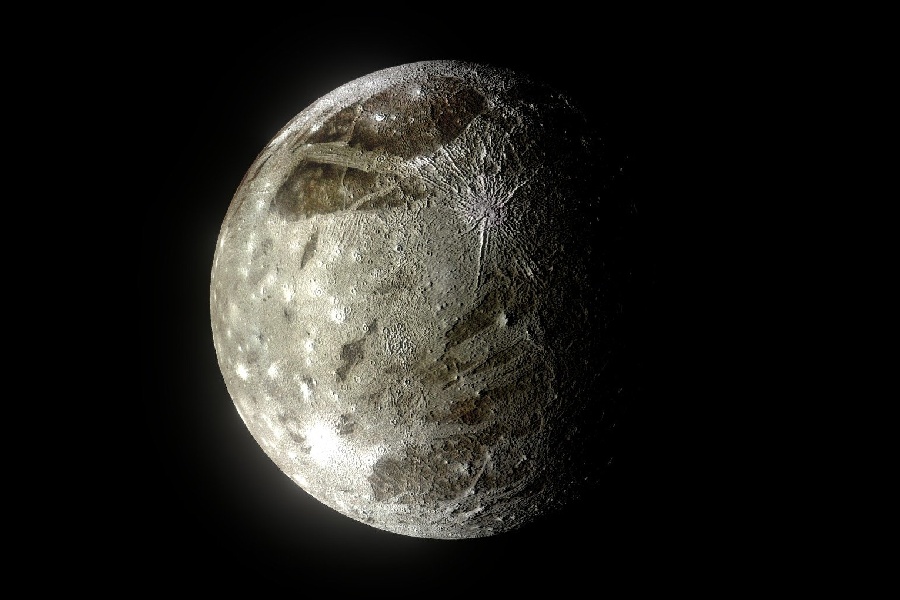Of Jupiter’s 95 confirmed moons, the enigmatic ice-wrapped world named Ganymede stands out as the largest in the entire solar system. This planet-sized moon fascinates researchers with its unusual characteristics and mysterious inner workings hiding beneath the web of fractures scarring its icy crust. But with most of its ice-crusted body unexplored, many mysteries hide below the cracked surface of Jupiter’s behemoth satellite. In this article, we will investigate some incredible facts about Ganymede that make this planet-sized moon special.
Join us as we cover findings about Ganymede’s buried ocean lying tens of kilometers beneath many miles of exotic red-brown ice. We will also discuss future NASA and ESA missions aimed at unlocking more mind-boggling Ganymede facts.

Facts About Ganymede
Ganymede, Jupiter’s largest moon, boasts several intriguing features. For starters, it’s the largest moon in our solar system. It exhibits a distinctive blend of rock and water ice on its surface. Ganymede is notable for possessing its magnetic field, a rarity among moons.
But when was Ganymede discovered? Scientists speculate about the presence of a subsurface ocean beneath its icy crust. It was discovered by Galileo Galilei in 1610. Ganymede is captivating with its size, unique composition, magnetic characteristics, and the potential for hidden oceans.
One of the many fun facts about Ganymede is how did Ganymede get its name. Ganymede, Jupiter’s largest moon, got its name from Greek mythology. Ganymede was a handsome Trojan prince abducted by Zeus, who transformed him into the cupbearer of the gods. The moon’s name reflects its role as the largest satellite of the largest planet in our solar system.
Ganymede’s Magnetic Field – A Surprising Magnetosphere
In 1996, NASA’s Galileo probe discovered that Ganymede has its own permanent magnetic field. Some fun facts about Ganymede is that’s the only moon besides Earth’s to retain a stable, global magnetosphere. Researchers were surprised, having assumed a body smaller than Earth could not sustain an internal magnetic dynamo.
Ganymede’s magnetosphere offers evidence of a still-churning metal core within defying models. It also creates awe-inspiring auroral bands around the moon’s poles from plasma rain. Measurements of irregularities in Jupiter’s magnetic field led Galileo scientists to first suspect Ganymede’s field.
Conclusively proven by later flyby data, Ganymede’s mini-magnetosphere overturns assumptions that only planets can generate persistent internal dynamo fields. Unlocking the origins of fields like Ganymede’s promises a deeper understanding of planetary evolution.
Water Ice and Rock – Ganymede’s Dual Personality
Ganymede’s surface is mostly water ice but contaminated by darker compounds like silicate rock fragments from the subsurface.
This gives some regions layered bands tinted red or orange. Infrared finds ice patches surrounded by rockier terrain – microscopic dirt coating the ice. Impacts over billions of years have scrambled this stratification widely.
The assorted ice and rock materials making up the surface provide clues into Ganymede’s past eruptive and tectonic activity. Detection of ice-enriched salts supports possible past oceans. Silicate minerals mixed throughout the ice indicate past melting blended subsurface rock layers into the now solid icy crust.
Ganymede’s Cratered Landscape – Ancient Testaments
Ganymede’s heavily cratered surface records the moon’s tremendous age – nearly 4.5 billion years. Craters appear in all sizes, from micro-divots to basins over 600 km wide, preserving primordial features despite local disruption. Crater distribution shows the polar ice crust thickening over time.
The meteorite impacts provide a timeline connecting geological events. Denser preserved craters indicate older terrain, while sparser neighboring regions signify more recent resurfacing. Counting craters acts like a clock to date processes by comparison to lunar samples.
Simulating icy crater shapes also reveals subsurface layer properties at impact sites. Whether solid ice bedrock, slushy mixtures, or lingering liquid water patches. So, the enduring impact scars recount 4 billion years of Ganymede’s evolution.
Grooved Terrain – Mysterious Patterns
The most distinctive regions on Ganymede are intricate grooved furrows crisscrossing the icy landscape in parallel and interleaved bands hundreds of km long. The fractures likely reflect tremendous geological stresses on the crust, but their origins remain uncertain.
Some associations exist between groove locations and ancient craters or basins. However, patterns still appear organized independently of specific basins, cutting across other landforms, suggesting an extensive resurfacing of Ganymede rather than localized adjustments.
Theories for the grooves include subsurface freezing and expanding ice. Shoved ice blocks from thrust faulting or tidal heating stresses deforming the crust in set patterns. No perfect explanation accounts for all groove aspects, though.
Ganymede’s Internal Structure – Layers of Secrets
Ganymede likely has a multilayered structure – an icy crust encompassing a subsurface ocean, high-pressure ice, and iron-nickel core. Gravity data reveals mass differences, suggesting internal composition zones. Ganymede’s density implies equal parts ice and denser rocks.
The 100-200 km ocean resides under a 150-200 km thick icy crust, over three times Europa’s. Saltwater convection currents could help the core generate Ganymede’s magnetic field. This vast, stable ocean probably persists today partly from tidal heating. Future missions may sample its potentially life-supporting alkaline waters by drilling through the insulating ice.
A conductive ocean churning around a dynamic core offers conditions for rocky seafloor life like in Earth’s deep habitats – ingredients include minerals, energy, and liquid water contacting rock chemistry. Gravity and surface information strengthen estimates about this ocean’s large volume and potential biological processes.
Conclusion
Ganymede displays exceptional properties, setting it lightyears apart from all other moons – from its gigantic size to the bursts of auroras fueled by its very own magnetosphere.
Gazing up at Ganymede gliding beside volcanic Io, we now better appreciate the facts about Ganymede, which have revealed mysteries surrounding our solar system’s largest moon.
As future missions pierce the exotic frozen barriers hiding a buried ocean, we will undoubtedly uncover even more astonishing revelations about the Jupiter-facing planet acting anything but moon-like in mass, dynamics, or magnitude.
